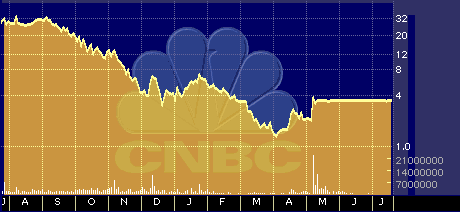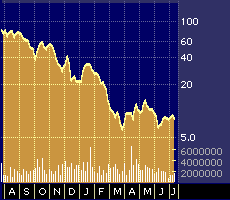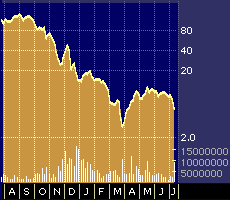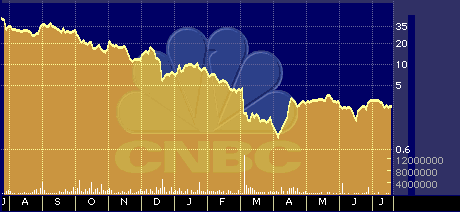
Caching Stocks Lead Internet Sector
Caching Stocks Lead Internet Sector
by Hal Plotkin
Silicon Valley Correspondent
Several trend-spotting analysts say they expect to see a small group of white-hot caching — or controlled content distribution — stocks, such as Akamai Technologies Inc. {AKAM}, Cacheflow Inc. {CFLO}, Digital Island Inc. {ISLD} and Inktomi {INKT}, continue to lead the Internet sector for years to come.
“I don’t think the stocks have gotten ahead of themselves,” says James Linnehan, an analyst at Thomas Weisel Partners, based in New York. “The opportunity is still in front of these companies.”
CCD stocks have skyrocketed this year. Digital Island, for example, was an $8 stock just 12 months ago. The stock more than doubled in October after the firm announced a stock-for-stock merger with Sandpiper Networks.

Digital Island post-IPO stock performance
Brent Bracelin, an analyst at Pacific Crest Securities, based in Seattle, says he sees even more upside potential for Digital Island’s stock.
“We believe Digital Island has room for another double based on the enormous market opportunity, its leading position given [its] strategic alliances and its. . .valuation relative to competing content delivery plays,” Bracelin wrote in a Dec. 13 research note. Digital Island was trading at $139 at the time.
Like Bracelin, many Internet analysts are now quite bullish on the CCD sector, which only recently came into being.
CCD firms typically began in the data-caching business. Caching refers to the storage of data on servers in remote locations which allows data to be served up much faster than would be the case if it all had to come from one single, centralized server. Caching remains a core technology of many of the firms in the exploding CCD sector, such as Akamai and Inktomi.

Akamai post-IPO stock performance

Inktomi 52-week stock performance
But caching firms have also expanded their product lines to provide clients with an ever-growing menu of services, such as user profiling and Internet performance measurement. Hence the more-expansive CCD sector description.
“We’re talking about the future of how data is distributed on the Internet,” says Joel Yaffe, an analyst at the Giga Information Group in Boston.
Yaffe recently issued a research paper that forecasts sales of several billion dollars in the CCD sector over the next three to five years.
“These services will fuel the broadband adoption rate for U.S. Internet users and will become a key enabling service, resulting in a shift from the Internet as a business tool to an interactive entertainment medium,” Yaffe wrote.
What’s more, Yaffe says CCD companies will play a major role in helping the Internet more effectively reach currently undeserved regions, such as India, Latin America, the Middle East and the Pacific Rim, which are distant from the major U.S. and European hubs where large amounts of Internet data are generated.
“Bringing the Internet to the developing world is not going to be done by antiquated telecommunications services,” Linnehan agrees. “It’s going to be done by companies like Digital Island and Inktomi. They’re capturing markets that are still in their infancy.”
Generally speaking, CCD firms fall into one of two categories: service providers, such as Akamai and Digital Island, and companies that focus more on selling data caching hardware and software, ranging from relative newcomers such as Cacheflow and Inktomi to more-established players such as Cisco Systems Inc. {CSCO} and Novell Inc. {NOVL}.
Both camps have their fans.
“The hardware/software guys like Cisco and Novell are well positioned to take advantage of the market no matter what happens,” Yaffe says. “They’re selling picks and shovels to the miners.”
“I think there are advantages to the service model,” Linnehan counters. “There’s a better return-on-investment, recurring revenues, and more opportunities on the service side.” Service providers, he notes, generate revenue by hosting client data on servers located around the world.
Bracelin says investors should also consider InterNAP Network Services Corp. {INAP}, another stock he says should run with the CCD market leaders because of its similar business model.
Internap brokers bandwidth from multiple providers to ensure the fastest possible data transmissions. The services firm counts many of the Web’s most bandwidth-intensive users, such as Amazon.com Inc. {AMZN}, eBay Inc. {EBAY} and Web TV, among its customers.

InterNAP Network Services post-IPO stock performance
Bracelin put a “buy” rating on the stock earlier this month after it had already climbed 570 percent over its September IPO price.
“We predict Internap will grow at a 108 percent compound annual growth rate over the next six years,” Bracelin wrote. “We consider Internap an emerging virtual carrier poised for explosive growth.”
No one knows for certain whether high-flying CCD stocks will maintain their stellar performance. But analysts say that as long as the Internet boom continues and as long as there is an increasing need to deliver ever-growing amounts of data to end users around the world, the stocks of companies addressing that market have every opportunity to enjoy a good, long run.
“The CCD business has a lot of upside,” Yaffe says. “It’s too early to tell who will be the winners and losers over the long run. But in the meantime, there’s an exploding demand for CCD services and the related hardware and software.”


